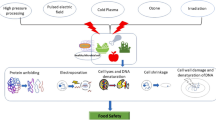Abstract
A calorimeter cell has been developed utilizing a geometry which optimizes dynamicgas flow and quantitative heat transfer to each sensing thermocouple. The basis of the cell is a sensitive thin form differential thermocouple which is symmetrically and rigidly positioned, containing a center port. The thin form differential thermocouple serves as a sample and sample container support as well as a differential detector. The dynamic gas enters through the center port permitting good contact with the sample and sample pan adjacent to it. The theoretical aspects are discussed and the necessity of having a high thermal resistance between the heat source and sample and a low thermal resistance between the sample and detecting thermocouple is demonstrated. Applications which show both qualitative and quantitative capabilities are presented.
Résumé
On a mis au point une cellule calorimétrique dont la conception est favorable à la circulation d'un courant gazeux et au transfert quantitatif de la chaleur vers chaque thermocouple détecteur. Le fond de la cellule est constitué par un thermocouple différentiel fin et sensible, disposé symétriquement et d'une manière rigide, et dont le centre est muni d'un orifice. Ce fin thermocouple différentiel sert de support d'échantillon et de détecteur différentiel. La circulation du gaz s'effectue par l'orifice central qui permet un bon contact avec l'échantillon et le support d'échantillon qui lui est adjacent. Les aspects théoriques sont discutés et l'on montre la nécessité d'une résistance thermique élevée entre la source de chaleur et l'échantillon et faible entre l'échantillon et le thermocouple détecteur. Des applications illustrent les possibilités qualitatives et quantitatives de ce dispositif.
Zusammenfassung
Es wird über eine kalorimetrische Zelle mit einer Geometrie, die einen optimalen Gasstrom und quantitative Wärmeübermittlung zu jedem Thermoelement ermöglicht, berichtet. Die Zelle besteht aus einem empfindlichen dünnen Thermoelement, das symmetrisch und fest angelagert ist und eine Öffnung in der Mitte besitzt. Das dünne Thermoelement dient zum Halten der Probe, des Probebehälters und als Differentialdetektor. Das dynamische Gas tritt durch die Öffnung ein, wodurch eine gute Berührung mit Probe und umgebendem Probebehälter ermöglicht wurde. Die theoretischen Aspekte werden erörtert und es wird bewiesen, daß zwischen der Wärmequelle und der Probe ein hoher, zwischen dem messenden Thermoelement und der Probe ein niedriger thermischer Widerstand nötig ist. Anwendungen informieren über die qualitativen und quantitativen Fähigkeiten der Zelle.
Резюме
Сконструирована кал ориметрическая ячей ка, обладающая геометри ей для оптимализации динам ического потока газа и количественного пер ехода теплоты к каждо й чувствительной терм опаре. Основание ячей ки является чувствительной дифф еренциальной термопарой, помещенн ой симметрично и непо движно, и, таким образом, содерж ит вход в центре. Диффере нциальная термопара служит подставкой для конте йнера образца, а также дифференциал ьным детектором. Пото к газа проходит через центр альный вход, что создает хороший к онтакт образца с чашк ой, содержащей образец. О бсуждены теоретичес кие аспекты и обусловлен а необходимость высо кого термического сопрот ивления между образцом и дете ктирующей термопаро й. Показаны некоторые пути приме нение ячейки с возможность ю качественных и коли чественных измерений.
Similar content being viewed by others
References
M. J. Vold, Anal. Chem., 21 (1949) 683.
S. L. Boersma, J. Am. Ceram. Soc., 38 (1955) 281.
S. L. Boersma, J. Am. Ceram. Soc., 40 (1957) 42.
H. J. Borchardt andF. J. Daniels, J. Am. Chem. Soc., 79 (1957) 41.
E. M. Barrall andL. B. Rogers, Anal. Chem., 34 (1962) 1101.
E. M. Barrall, R. S. Porter andJ. F. Johnson, Anal. Chem., 36 (1964) 2172.
D. J. David, Anal. Chem., 36 (1964) 2162.
L. G. Berg andV. P. Egunov, J. Thermal Anal., 1 (1969) 5.
L. G. Berg andV. P. Egunov, J. Thermal Anal., 1 (1969) 441.
L. G. Berg andV. P. Egunov, J. Thermal Anal., 2 (1970) 53.
D. J. David, The Effect of Environment on Quantative Measurements by Differential Scanning Calorimetry, in Analytical Calorimetry, Vol. II,R. Porter andJ. F. Johnson, Eds., Plenum Publishing Company, New York, 1970.
H. G. Wiedemann andA. Van Tets, Thermochim. Acta, 1 (1970) 159.
A. P. Gray, A Simple Generalized Theory for the Analysis of Dynamic Thermal Measurement, in Analytical Calorimetry, Vol. I,R. Porter andJ. F. Johnson, Eds., Plenum Publishing Company, New York, 1968.
L. O. Olsen andP. D. Freeze, NBS. J. Res., 68C (1964) 263.
W. H. King, Jr., C. T. Camilli andA. F. Findeis, Anal. Chem., 40 (1968) 1330.
D. J. David, Transition Temperatures in Differential Thermal Analysis, Chapter 2, Polymer Thermal Analysis,P. Slade andL. Jenkins, Eds., Marcel Dekker, New York, 1966.
D. J.David, American Lab., January, 1970, p. 35.
Author information
Authors and Affiliations
Rights and permissions
About this article
Cite this article
David, D.J. Performance of a new differential scanning calorimeter cell. Journal of Thermal Analysis 3, 247–258 (1971). https://doi.org/10.1007/BF01912108
Received:
Issue Date:
DOI: https://doi.org/10.1007/BF01912108




